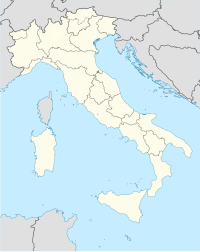 Giant head from Mont'e Prama | |
| Location | Cabras, Province of Oristano |
|---|---|
| Region | Sinis peninsula, Sardinia, Italy |
| Coordinates | 39°57′57″N 8°26′54″E / 39.965778°N 8.448278°E |
| Type | Sculptures |
| Part of | Heroon, Giants' grave, Necropolis (debated) |
| Area | ≈ 75000 m2 |
| Height | 2.5 metres (8 ft 2 in) |
| History | |
| Builder | Nuragic Sardinians |
| Material | limestone |
| Founded | Between the 11th and the 8th century BC (debated) |
| Abandoned | Late 4th century BC – first decades of the 3rd century BC |
| Periods | Iron Age I |
| Cultures | Nuragic civilisation |
| Associated with | Nuragic aristocrats |
| Events | Sardo–punic wars (debated) |
| Site notes | |
| Excavation dates | 1974: G. Atzori; 1975: A. Bedini; 1977: G. Lilliu, G. Tore, E. Atzeni; 1977: G. Pau, M. Ferrarese Ceruti – C. Tronchetti |
| Condition | Sculptures restored at the Centro di restauro e conservazione dei beni culturali of Li Punti (Sassari) — Necropolis not yet fully excavated |
| Ownership | Public |
| Public access | Yes |
| Website | monteprama.it |
The Giants of Mont'e Prama (Italian: Giganti di Mont'e Prama; Sardinian: Zigantes de Mont'e Prama[1] [dziˈɣantɛz dɛ ˈmɔntɛ ˈβɾama]) are ancient stone sculptures created by the Nuragic civilization of Sardinia, Italy. Fragmented into numerous pieces, they were discovered in March 1974 on farmland near Mont'e Prama, in the comune of Cabras, province of Oristano, in central-western Sardinia. The statues are carved in local sandstone and their height varies between 2 and 2.5 meters.[2]
After four excavation campaigns carried out between 1975 and 1979, the roughly five thousand pieces recovered – including fifteen heads and twenty two torsos – were stored for thirty years in the repositories of the National Archaeological Museum of Cagliari, while a few of the most important pieces were exhibited in the museum itself.[3] Along with the statues, other sculptures recovered at the site include large models of nuraghe buildings and several baetyl sacred stones of the "oragiana" type, used by Nuragic Sardinians in the making of "giants' graves".[a]
After the funds allocation of 2005 by the Italian Ministry of Cultural Heritage and the Sardinia Region, restoration was being carried out from 2007 until 2012 at the Centro di restauro e conservazione dei beni culturali of "Li Punti" (Sassari), coordinated by the Soprintendenza of cultural heritage for Sassari and Nuoro, together with the Soprintendenza of Cagliari and Oristano. At this location, twenty five statues, consisting of warriors, archers, boxers, and nuraghe models, have been exhibited to the public at special events since 2009.[4] The exhibition has become permanently accessible to the public since November 2011.
According to the most recent estimates, the fragments came from a total of forty-four statues. Twenty-five have already been restored and assembled in addition to thirteen nuraghe models, while another three statues and three nuraghe models have been identified from fragments that cannot currently be reconstructed. Once the restoration has been completed, it is planned to return the majority of the finds to Cabras to be displayed in a museum.[4][5]
Depending on the different hypotheses, the dating of the Kolossoi – the name that archaeologist Giovanni Lilliu gave to the statues[6] – varies between the 11th and the 8th century BC.[7] If this is further confirmed by archaeologists, they would be the most ancient anthropomorphic sculptures of the Mediterranean area, after the Egyptian statues, preceding the kouroi of ancient Greece.[8]
The scholar David Ridgway on this unexpected archaeological discovery wrote:
... during the period under review (1974–1979), the Nuragic scene has been enlivened by one of the most remarkable discoveries made anywhere on Italian soil in the present century (20th century)...
— David Ridgway, Archaeology in Sardinia and Etruria, 1974 – 1979. Archaeological Reports, 26 (1979–1980), pp 54–70,[9]
while the archaeologist Miriam Scharf Balmuth said:
...a stunning archaeological development, perhaps the most extraordinary find of the century in the realm of art history ...
— Joseph J. Basile, The Capestrano Warrior and Related Monuments of the Seventh to Fifth Centuries B.C, p 22.[10]
- ^ Cite error: The named reference
Marco Camedda (2012)was invoked but never defined (see the help page). - ^ Cite error: The named reference
The Independentwas invoked but never defined (see the help page). - ^ Cite error: The named reference
Roberto Nardi (2008)was invoked but never defined (see the help page). - ^ a b Cite error: The named reference
Mont'e Prama Prenda 'e Zeniawas invoked but never defined (see the help page). - ^ Cite error: The named reference
La Nuovawas invoked but never defined (see the help page). - ^ Quoted by Lilliu (2006), pp. 84–86.
- ^ Cite error: The named reference
Alice Andreoli (2007)was invoked but never defined (see the help page). - ^ Cite error: The named reference
V.Leonelliwas invoked but never defined (see the help page). - ^ Cite error: The named reference
David Ridgway (1980)was invoked but never defined (see the help page). - ^ Cite error: The named reference
Joseph J. Basile(2004)was invoked but never defined (see the help page).
Cite error: There are <ref group=lower-alpha> tags or {{efn}} templates on this page, but the references will not show without a {{reflist|group=lower-alpha}} template or {{notelist}} template (see the help page).
